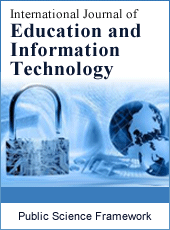International Journal of Education and Information Technology
Articles Information
International Journal of Education and Information Technology, Vol.2, No.2, Apr. 2016, Pub. Date: Mar. 18, 2016
Laboratory Educational Authority Website Development
Pages: 8-13 Views: 3086 Downloads: 1367
[01]
Izak B. Dimenstein, Loyola University Chicago Medical Center (Ret.), Grand Rapids, MI, USA.
The article presents ways by which an authority site can be developed and maintained as a reputed source of specific, including educational, digital information. For the Internet sustainability of a laboratory educational authority website, the search engines' work should be taken into account in the entire website's framework design in general, as well as its webpages in particular. While the informative value of the site is paramount, the strategic use of keywords, even phases on the pages can enhance the visibility. Fragmentation of the material on pages is beneficial. The composition of the website can use hyperlinks to draw attention to previous posts. The article is based on our more than a decade expertise of maintaining the” Grossing Technology in Surgical Pathology” (www.grossing-technology.com) website. The methodology of building a specialized authority website can be expended to further development of educational websites, including website’s aggregation in portals. The principles of the development a sustainable laboratory niche website are discussed in the article “Development of a Laboratory Niche Website” published in Annals of Diagnostic Pathology in 2013. The current article is a continuation of it. There has been no similar work in the accessible literature.
Authority Website, Niche Website, Search Engine Optimization, Web Crawlers
[01]
I. B. Dimenstein and S. I. Dimenstein, “Development of a Laboratory Niche Web site”, Ann Diagn Pathol, vol 17, pp. 448-456, October 2013.
[02]
J. Smith, “Authority Site Buildingand Leveraging Website Authority”, Available:http://www.seodesignsolutions.com/blog/how-to-reference-material/authority-site-building-and-leveraging-website-authority/ (accessed December, 2015).
[03]
M. Schrenk, Webbots, Spiders, and Screen Scrapers. A Guide to developing Internet Agents with PHP/CURL. 2ed; No Starch Press, San Francisco. 2012; p.174.
[04]
Google. Webmaster Guidelines. Available: . (accessed December, 2015.)
[05]
I. B. Dimenstein, “Grossing biopsies: an introduction to general principles and techniques”, Ann Diagn Pathol, vol 13, pp. 106-113, April 2009.
[06]
R. H. Alyusuf, K. Prasad, A. M. Abdel Satir, A. A. Abalkhail, and R.K. Arora, “Development and validation of a tool to evaluate the quality of medical education websites in pathology”, J Pathol Inform, pp.4:29, 2013.
[07]
P. Gaston, “The Modern Web. Multi-device web development with HTML5, CSS3, and JavaScript”, No Starch Press, San Francisco. 2012; pp. 2-7.
[08]
M. MacDonald. Creating a Website the Missing Manual. 3rd Edition, O’Reilly Media, Inc., 2011.
[09]
M. Bell. Build a Website for Free. Third Edition, Person Education Inc., 2013.
[10]
S. Thurow. Search Engine Visibility. 2nd Edition, New Riders, 2008.
[11]
P. McNeil. The Designer’s Web Handbook (What You Need to Know to Create for the Web) How Books, Cincinnati, Ohio, 2012.
[12]
S. Parker. The Web Designer’s 101 Most Important Decisions: Professional Secrets for A Winning Website. F+W.

ISSN Print: 2381-7410
ISSN Online: 2381-7429
Current Issue:
Vol. 5, Issue 1, March Submit a Manuscript Join Editorial Board Join Reviewer Team
ISSN Online: 2381-7429
Current Issue:
Vol. 5, Issue 1, March Submit a Manuscript Join Editorial Board Join Reviewer Team
| About This Journal |
| All Issues |
| Open Access |
| Indexing |
| Payment Information |
| Author Guidelines |
| Review Process |
| Publication Ethics |
| Editorial Board |
| Peer Reviewers |


